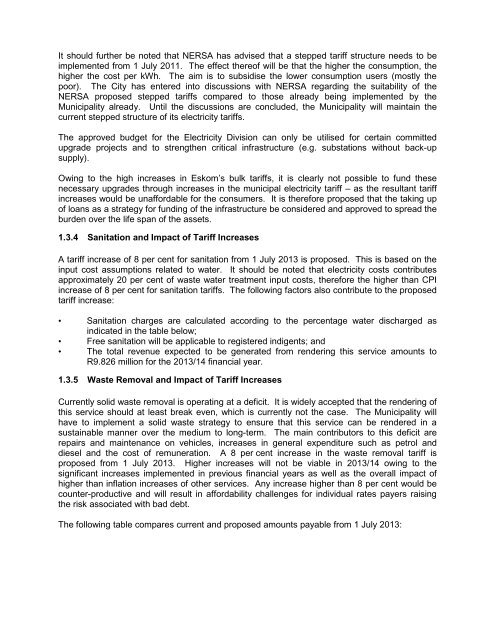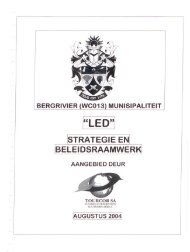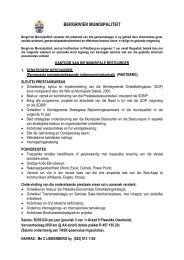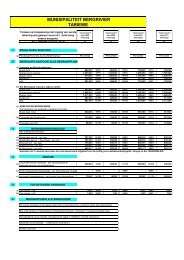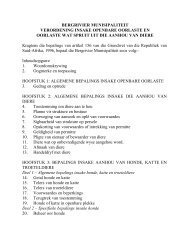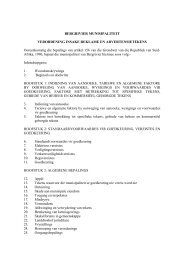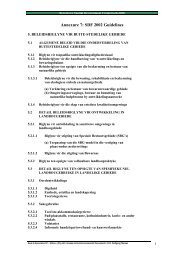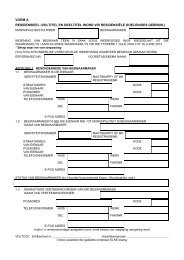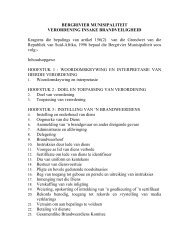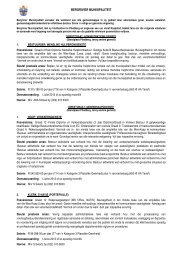2013/2014 Konsepbegroting en begrotingsverwante beleide
2013/2014 Konsepbegroting en begrotingsverwante beleide
2013/2014 Konsepbegroting en begrotingsverwante beleide
Create successful ePaper yourself
Turn your PDF publications into a flip-book with our unique Google optimized e-Paper software.
It should further be noted that NERSA has advised that a stepped tariff structure needs to be<br />
implem<strong>en</strong>ted from 1 July 2011. The effect thereof will be that the higher the consumption, the<br />
higher the cost per kWh. The aim is to subsidise the lower consumption users (mostly the<br />
poor). The City has <strong>en</strong>tered into discussions with NERSA regarding the suitability of the<br />
NERSA proposed stepped tariffs compared to those already being implem<strong>en</strong>ted by the<br />
Municipality already. Until the discussions are concluded, the Municipality will maintain the<br />
curr<strong>en</strong>t stepped structure of its electricity tariffs.<br />
The approved budget for the Electricity Division can only be utilised for certain committed<br />
upgrade projects and to str<strong>en</strong>gth<strong>en</strong> critical infrastructure (e.g. substations without back-up<br />
supply).<br />
Owing to the high increases in Eskom’s bulk tariffs, it is clearly not possible to fund these<br />
necessary upgrades through increases in the municipal electricity tariff – as the resultant tariff<br />
increases would be unaffordable for the consumers. It is therefore proposed that the taking up<br />
of loans as a strategy for funding of the infrastructure be considered and approved to spread the<br />
burd<strong>en</strong> over the life span of the assets.<br />
1.3.4 Sanitation and Impact of Tariff Increases<br />
A tariff increase of 8 per c<strong>en</strong>t for sanitation from 1 July <strong>2013</strong> is proposed. This is based on the<br />
input cost assumptions related to water. It should be noted that electricity costs contributes<br />
approximately 20 per c<strong>en</strong>t of waste water treatm<strong>en</strong>t input costs, therefore the higher than CPI<br />
increase of 8 per c<strong>en</strong>t for sanitation tariffs. The following factors also contribute to the proposed<br />
tariff increase:<br />
• Sanitation charges are calculated according to the perc<strong>en</strong>tage water discharged as<br />
indicated in the table below;<br />
• Free sanitation will be applicable to registered indig<strong>en</strong>ts; and<br />
• The total rev<strong>en</strong>ue expected to be g<strong>en</strong>erated from r<strong>en</strong>dering this service amounts to<br />
R9.826 million for the <strong>2013</strong>/14 financial year.<br />
1.3.5 Waste Removal and Impact of Tariff Increases<br />
Curr<strong>en</strong>tly solid waste removal is operating at a deficit. It is widely accepted that the r<strong>en</strong>dering of<br />
this service should at least break ev<strong>en</strong>, which is curr<strong>en</strong>tly not the case. The Municipality will<br />
have to implem<strong>en</strong>t a solid waste strategy to <strong>en</strong>sure that this service can be r<strong>en</strong>dered in a<br />
sustainable manner over the medium to long-term. The main contributors to this deficit are<br />
repairs and maint<strong>en</strong>ance on vehicles, increases in g<strong>en</strong>eral exp<strong>en</strong>diture such as petrol and<br />
diesel and the cost of remuneration. A 8 per c<strong>en</strong>t increase in the waste removal tariff is<br />
proposed from 1 July <strong>2013</strong>. Higher increases will not be viable in <strong>2013</strong>/14 owing to the<br />
significant increases implem<strong>en</strong>ted in previous financial years as well as the overall impact of<br />
higher than inflation increases of other services. Any increase higher than 8 per c<strong>en</strong>t would be<br />
counter-productive and will result in affordability chall<strong>en</strong>ges for individual rates payers raising<br />
the risk associated with bad debt.<br />
The following table compares curr<strong>en</strong>t and proposed amounts payable from 1 July <strong>2013</strong>:


